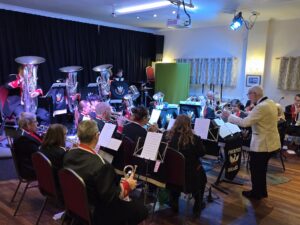Mick Dowedeswell
May 2023
I learnt an interesting piece of history from one time resident of the Hinds Head that has been puzzling me for years. I met Gil Wall at the Upper Lambourn cemetery a couple of days ago, with him paying his respects to his late wife. He is an absolute mine of information and at 94 years of age, looks remarkable too.

His story goes thus: A man by the name of Bill Fisher, was a horses and stage coach driver in the late 1800s. He would walk from Collingbourne Ducis to the Hinds Head in Lambourn, to drive the stage coach to the Bear in Wantage, where he would collect passengers coming down from the Midlands and elsewhere. Arriving back at the Hinds Head, he would change the horses and proceed onto the Bear at Hungerford, where they’d meet the other stage coach on the Bath Road. Return to Lambourn, change horses and onwards to Wantage, doing this about two or three times a day. It was then a long walk back to Collingbourne Ducis.
Eventually, when the stage coaches finished, due to motorised vehicles coming in after the turn of the century, Bill, retired and managed to get an Alms House in Lambourn, where he became Head Almsman.

In the early days, the almsmen had to go to church regularly and this is where my interest comes in. I knew there were substantial tunnels radiating from the old Lambourn Place, but most likely, these stemmed from the turbulent times of the 15th and 14th century and not when Henry Hippisley built his mansion on the previous mansion’s footings. I am sure there was a tunnel leading to the stables (towards the British Legion), definitely one to the Alms Houses, and a good possibility of one leading to somewhere near the Hippisley vault. Maureen McDonald definitely remembers the one to the Alms houses and I have actually seen that one.
When Bill Fisher was there and when it rained, the Almsmen travelled from the Almshouses underground through a tunnel to the church and came up at the back of the organ! I have a book, written by the late Thomas Rice, who was in C Company of the US 501st Parachute Infantry Company and they were stationed in the grounds of Lambourn Place, which by this time in 1944, the mansion had been demolished back in 1938. In his book, he describes exploring the tunnels with his buddies and actually arriving inside the church (unknown to the local parishioners at the time!)
Gill Wall lived with his parents, who kept the Hinds Head for years, and that was a busy place for the Sherwood Foresters through the war, with much ammunition stored in the stables and a workshop for repairing Bren Gun carriers in a large shed at the top of the yard. Bill Fisher eventually went to live with the Wall family at the Hinds Head.




